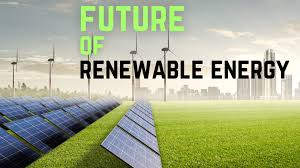Energy Market Trends: The Future of Renewable Energy
Introduction
The world’s energy system is changing fast. For many decades, we have depended on coal, oil, and gas to power our homes, cars, and factories. But these sources of energy harm the environment and cause pollution and climate change.
Today, the focus is shifting toward renewable energy — clean energy that comes from natural sources like the sun, wind, and water. This change is not just good for the planet, it is also creating new business opportunities, jobs, and technologies.
In this article, we will explore the latest energy market trends, why renewable energy is growing so quickly, and what the future of clean energy looks like in simple and easy words.
What Is Renewable Energy?
Renewable energy means energy that comes from sources that never run out. Unlike coal and oil, which take millions of years to form, renewable sources are naturally replaced by nature every day.
Common Types of Renewable Energy
-
Solar Energy – Power from sunlight using solar panels.
-
Wind Energy – Electricity created by wind turbines.
-
Hydropower – Energy from moving water in dams or rivers.
-
Geothermal Energy – Heat from beneath the Earth’s surface.
-
Biomass Energy – Power from organic materials like plant waste or animal waste.
These energy sources are clean, sustainable, and essential for the world’s green future.
Why the World Is Shifting to Renewable Energy
There are several reasons why renewable energy is becoming the center of global attention:
1. Climate Change and Pollution
Fossil fuels release harmful gases like carbon dioxide (CO₂), which trap heat and cause global warming. This leads to extreme weather, melting ice caps, and rising sea levels. Renewable energy produces little or no emissions, making it the best solution for a healthy planet.
2. Falling Costs of Technology
A decade ago, installing solar panels or wind turbines was expensive. But today, the prices have dropped sharply due to better technology and mass production. Renewable energy is now cheaper than fossil fuels in many countries.
3. Energy Security
By using local renewable sources, countries can reduce their dependence on imported oil and gas. This helps them control their own energy prices and ensures a steady supply even during global crises.
4. Job Creation
The renewable energy industry is creating millions of new jobs worldwide. From engineers and technicians to construction workers, the clean energy sector is becoming one of the largest employers.
5. Government Policies
Many governments are supporting renewable energy through tax benefits, subsidies, and green policies. These incentives encourage both companies and individuals to invest in clean energy projects.
Global Market Trends in Renewable Energy
The global energy market is seeing rapid growth in clean energy projects. Here are some major trends shaping the future:
1. Solar Power Leading the Way
Solar power has become the most popular form of renewable energy. The cost of solar panels has dropped by nearly 80% in the last decade. Countries like China, India, and the United States are building huge solar farms to supply electricity to millions of homes.
Even at the household level, rooftop solar systems are becoming common. Many families are now generating their own electricity and even selling extra power back to the grid.
2. Wind Energy Expansion
Wind energy is growing fast in both onshore (land) and offshore (sea) projects. Modern wind turbines are larger, more efficient, and can generate more power than ever before.
In Europe, countries like Denmark and the UK lead in offshore wind farms. In the U.S. and India, onshore wind farms are expanding rapidly. Wind energy is reliable, especially in regions with consistent wind patterns.
3. Energy Storage Technology
One challenge with renewable energy is that it depends on weather — for example, solar power doesn’t work at night. To solve this, companies are developing battery storage systems that can store extra power when production is high and use it later when needed.
Battery technology is improving fast, and prices are falling. This is helping renewable energy become more stable and useful 24/7.
4. Smart Grids and Digital Energy Systems
Modern power grids are becoming “smart.” A smart grid uses technology and sensors to manage electricity better, reduce waste, and balance demand and supply in real time.
These systems make it easier to use renewable energy because they can handle changes in power generation and help deliver clean electricity more efficiently.
5. Electric Vehicles (EVs)
The rise of electric cars and buses is another big trend. EVs are powered by batteries that can be charged using renewable energy. This reduces pollution and oil consumption.
Major car companies are now switching to electric models, and many governments plan to ban petrol and diesel cars in the next 10–15 years. This will increase demand for renewable energy even more.
Challenges Facing Renewable Energy
While renewable energy is growing fast, it still faces a few challenges that need solutions:
1. Energy Storage
As mentioned earlier, renewable sources depend on weather. We need more advanced and affordable batteries to store energy for use at night or during calm, windless days.
2. Infrastructure and Investment
Building wind farms, solar parks, and smart grids needs huge investment. Some developing countries still struggle to find enough funding for these projects.
3. Land and Space Requirements
Large solar and wind projects need a lot of land, which can sometimes affect local communities or wildlife. Careful planning is needed to balance progress with environmental protection.
4. Recycling Old Equipment
Solar panels and wind turbine blades have a long life, but they will eventually need replacement. Finding eco-friendly ways to recycle them is becoming important.
5. Public Awareness and Education
People must understand the importance of renewable energy. More awareness means more support for clean energy programs and sustainable living.
The Future of Renewable Energy
The future of renewable energy looks bright and full of possibilities. Experts believe that by 2040, renewable sources will become the main source of global electricity.
Here’s what the next few decades might bring:
🌞 Smarter Solar Systems
Solar panels will become even more efficient, lighter, and flexible. New materials like perovskite could make solar energy cheaper and easier to install everywhere — even on windows and walls.
🌬️ Advanced Wind Power
Future wind turbines will be taller and more powerful. Floating offshore wind farms will generate electricity far from land, using strong sea winds.
🔋 Revolution in Energy Storage
Next-generation batteries will last longer and store more energy. Technologies like hydrogen storage will also play a big role in balancing renewable power.
🚗 Clean Transportation
Electric cars, bikes, and buses will become common, reducing pollution in cities. Renewable energy will power charging stations, creating a full clean-energy cycle.
🌍 Global Cooperation
Countries are working together through climate agreements like the Paris Accord to reduce carbon emissions. Sharing technology and resources will help make renewable energy available to everyone.
Benefits of a Renewable Future
-
Cleaner Air and Water – Less pollution means healthier people and a safer planet.
-
Lower Energy Bills – Once systems are installed, renewable energy is cheap to produce.
-
Job Opportunities – Millions of jobs in solar, wind, and energy storage industries.
-
Stable Economy – Less dependence on imported oil or gas keeps economies stable.
-
Better Quality of Life – Cleaner cities, less noise, and a greener world for future generations.
Conclusion
The world is moving toward a cleaner and smarter energy future. Renewable energy is not just an option — it’s a necessity. It protects the environment, creates jobs, and ensures long-term energy security for everyone.
While challenges still exist, technology and innovation are solving them one by one. Solar panels are becoming cheaper, wind turbines are getting stronger, and storage systems are improving every year.
The future of renewable energy is bright, sustainable, and full of opportunity. By adopting green technologies today, we are building a better tomorrow — one powered by the sun, wind, and water.

